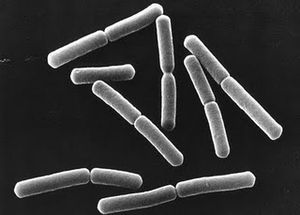Candidatus Accumulibacter Phosphatis: Difference between revisions
| Line 29: | Line 29: | ||
"Candidatus Accumulibacter phosphatis" is of the group of organisms know as polyphosphate-accumulating organisms (PAO). | "Candidatus Accumulibacter phosphatis" is of the group of organisms know as polyphosphate-accumulating organisms (PAO). | ||
This organism is used in waste water treatment for the purpose of enhanced biological phosphorus removal (EBPR)(Lu). Waste water effluent can be a major contributor of phosphorous pollution to the environment, which can cause excess nutrient loading that leads to algal blooms. Traditional methods of Phosphorous removal include chemical remobal process and EBPR. Advantages of operating a waste water treatment plant with EBPR are that it significantly lowers operating costs, reduces sludge production and enables sludege to be reused easier, and eliminates chemical biproducts. | This organism is used in waste water treatment for the purpose of enhanced biological phosphorus removal (EBPR)(Lu). Waste water effluent can be a major contributor of phosphorous pollution to the environment, which can cause excess nutrient loading that leads to algal blooms. Traditional methods of Phosphorous removal include chemical remobal process and EBPR. Advantages of operating a waste water treatment plant with EBPR are that it significantly lowers operating costs, reduces sludge production and enables sludege to be reused easier, and eliminates chemical biproducts (Blackall, 2002). | ||
==Genome Structure== | ==Genome Structure== | ||
Revision as of 15:04, 22 April 2010
PAGE UNDER CONSTRUCTION
Classification
Kingdom: Bacteria
Phylum: Proteobacteria
Class: Betaproteobacteria
Order: unclassified Betaproteobacteria
Family: Candidatus Accumulibacter
Species
Candidatus Accumulibacter phosphatis
NCBI Taxonomy ID: 522306 Sub Groups:
Description and Significance
Describe the appearance, habitat, etc. of the organism, and why you think it is important.
"Candidatus Accumulibacter phosphatis" is of the group of organisms know as polyphosphate-accumulating organisms (PAO).
This organism is used in waste water treatment for the purpose of enhanced biological phosphorus removal (EBPR)(Lu). Waste water effluent can be a major contributor of phosphorous pollution to the environment, which can cause excess nutrient loading that leads to algal blooms. Traditional methods of Phosphorous removal include chemical remobal process and EBPR. Advantages of operating a waste water treatment plant with EBPR are that it significantly lowers operating costs, reduces sludge production and enables sludege to be reused easier, and eliminates chemical biproducts (Blackall, 2002).
Genome Structure
Describe the size and content of the genome. How many chromosomes? Circular or linear? Other interesting features? What is known about its sequence?
NCBI Mapped Genome Online genome information
Cell Structure, Metabolism and Life Cycle
Interesting features of cell structure; how it gains energy; what important molecules it produces.
Ecology and Pathogenesis
Habitat; symbiosis; biogeochemical significance; contributions to environment. If relevant, how does this organism cause disease? Human, animal, plant hosts? Virulence factors, as well as patient symptoms.
References
Author
Page authored by Johanna Kinster and Kevin Koryto, students of Prof. Jay Lennon Prof. Jay Lennon at Michigan State University.

